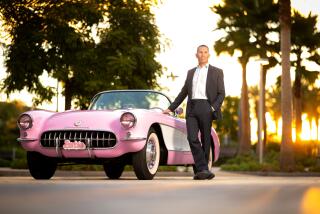All That Glittered Was Not Gold for Jewelry Retailer
- Share via
Barry’s Jewelers Inc. can’t seem to get out of its own way.
The Monrovia-based jewelry retailer, which emerged from bankruptcy in 1992 and recapitalized in 1993--promising shareholders a new era of growth--on Tuesday announced it must restate fiscal 1995 earnings and will report a pretax loss for fiscal 1996, which ended May 31.
The firm, whose 161 stores and $136 million in 1995 sales make it the fourth-largest independent jewelry retailer (under such names as Schubach, Hatfield and Samuels), said it discovered inventory accounting errors that produced a $1.5-million overstatement of diamond inventories in fiscal ’95.
Adjusting for gems that weren’t actually there, fiscal ’95 earnings of $2.8 million (70 cents a share) will be cut to about $1.3 million, Barry’s said.
Meanwhile, for fiscal 1996, a different accounting problem will cost $1 million in inventory adjustments, the firm said. An additional $1.5 million in one-time charges for certain legal fees and financial-transaction costs will produce a pretax loss of $2 million, Barry’s said.
The news sent the stock down $1.25 to $3.375 on Nasdaq. It sold as high as $7.125 last year.
*
Two different accounting problems occurring back to back are a shareholder’s worst nightmare, because they raise all sorts of questions about the reliability of a firm’s numbers. Just a year ago, Barry’s used its annual report to trumpet its “tighter financial controls” and “highly successful inventory management system.” Hmmmm.
Robert W. Bridel, Barry’s chief executive, said the fiscal 1995 problem amounted to human error--double counting of certain ledgers. A new automated inventory system for loose diamonds should assure that doesn’t happen again, he said.
The fiscal 1996 inventory issue is more prickly: It stemmed from “transactional problems” between the main office and some of the stores, Bridel said. Essentially, headquarters and the stores haven’t always been agreeing on the value of gems traded in by customers or the “correctness” of discounts granted by store salespeople.
Bridel said expansion of Barry’s “value pricing” plan, which reduces discretionary store discounting, will cut the risk of further inventory snafus.
He said Barry’s still expects to open 17 new stores between now and Christmas. Like many other retailers, Barry’s is moving increasingly toward the “superstore” concept, and Bridel says the shift is paying off with market-share gains.
What’s the stock truly worth? In the highly competitive jewelry business, who knows what Barry’s future earnings power really can be. But a group of eight big investors led by Gildea Management Co. of Greenwich, Conn., was willing to take 1.5 million Barry’s shares (37.5% of the 4 million outstanding) off the hands of former creditor Wells Fargo Bank in early May at a price believed to be $3 a share--not much below Tuesday’s close.
*
Buffett Was Right: When legendary investor Warren Buffett in May agreed to offer a lower-priced issue of stock in his company, Berkshire Hathaway, he took pains to warn people that even though they could buy it, they shouldn’t. The market was overpricing Berkshire relative to its assets, the ever-value-conscious Buffett said.
Although the sale of the new class B stock still was a huge hit--450,000 shares were sold at $1,110 apiece--Buffett’s effort to deflate the Berkshire mystique appears to be working.
The class B shares quickly peaked at $1,220 after the offering and have slid to $1,020 now, a 16.4% decline. The class A shares, $38,000 at their peak earlier this year, have slumped 19.5%, to $30,600 now. Those price declines make the recent “correction” in the stock market as a whole seem trivial. The Nasdaq composite index, for example, is off just 6.1% from its record high.
Buffett decided to issue the lower-priced shares to thwart Wall Street firms that were going to do much the same thing via unit investment trusts, without his blessing. Does Buffett really believe Berkshire is overpriced? William Mason, a Buffett watcher at Cullen, Fortier Asset Management in Woodland Hills, notes that even at the current cheaper prices, Berkshire shares trade for about twice the real value of the underlying assets. Noting Berkshire’s big stake in Coca-Cola, among other Buffett favorites, Mason says simply, “It’s an awfully expensive way to buy Coke.”
(BEGIN TEXT OF INFOBOX / INFOGRAPHIC)
Berkshire’s Swoon
The Class A shares of Berkshire Hathaway--Warren Buffett’s investment vehicle--have fallen nearly 20% from their recent peak. Biweekly closes on the New York Stock Exchange, and latest, in thousands:
Tuesday: $30,600
Source: Bloomberg Business News
More to Read
Inside the business of entertainment
The Wide Shot brings you news, analysis and insights on everything from streaming wars to production — and what it all means for the future.
You may occasionally receive promotional content from the Los Angeles Times.










